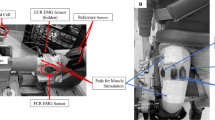Abstract
Excitability in a cortical representation of a foreleg was determined during elaboration of transswitching in dogs in three variations depending upon the stimulus used as a Conditioned stimulus (CS). If the flexor reaction to direct stimulation of the motor cortex was used as a CS, excitability changes of opposite signs appeared in the cortical representation of the foreleg, the threshold of flexion decreased in the alimentary situation and increased in the defense situation. Such changes in excitability were observed during instrumental conditioned transswitching. If subthreshold stimulation of the motor cortex was used as the CS, the threshold of flexion increased in both situations in approximately equal degree.
Similar content being viewed by others
References
Asratyan, E. A. About mechanism and localization of conditioned inhibition. In essays about physiology of conditioned reflexes. M.,Science, 1970, 337–357.
Asratyan, E. A. Lectures about some questions of neurophysiology.About Physiology Conditioned Reflex. M., 1959, pp. 127–153.
Asratyan, E. A. Some peculiarities of the formation, functioning and inhibition of conditioned reflex with the two-way connections.Zhurnal Vysshei Nervnoi Deiatelnosti imeni I. P. Pavlova,15, 796–807.
Borukaev, R. K. Changes in EEG and evoked potentials during elaboration of situation defense conditioned reflex and during transswitching. In:Electrophysiology of C.N.S. (V Conference), Tbilisi, 1966, 44.
Borukaev, R. K. Dependence of characteristics of cortical evoked potentials on signal signification of acoustic stimulus during transswitching.Zhurnal Vysshei Nervnoi Deiatelnosti Imeni, 1970,N 6, 1168–1174.
Davydova, E. K. Changes in the threshold of motor reaction to a direct electrical stimulation of the motor cortex during elaboration of conditioned transswitching.Zhurnal Vysshei Nervnoi Deiatelnosti Imeni, 1981,XXXI, 6, 1141–1148.
Davydova, E. K. Changes of excitability in cortical representation of signal stimulus during elaboration of conditioned alimentary reflex.Dokl. AN SSSR, 1965,162, 1437.
Davydova, E. K. Transswitching of alimentary and defense conditioned reflexes with foreleg passive flexion as a signal stimulus.Zhurnal Vysshei Nervnoi Deiatelnosti Imeni, 1979,24, 6, 1303–1305.
Doty, R. W. Conditioned reflexes elicited by electrical stimulation of the brain in macaques.Journal of Neurophysiology, 1965,28, 4, 623–640.
Doty, R. W., Qiurgea, C. M. Conditioned reflexes established by coupling electrical excitation of two cortical areas. In:Brain Mechanisms and Learning. Symos. CIOMS Oxford, 1961, 133–151.
Doty, R. W., Rutledge, L. T., Larsen, R. M. Conditioned reflex established to electrical stimulation of cat cerebral cortex.Journal of Neurophysiology, 1965,19, 5, 401–415.
Erofeeva, M. N. Electrical stimulation of the dog’s cutaneous as a conditioned stimulus for the work of the salitary glands. Dissertation. St. Petersburg, 1912, Moscow, 1953.
Evarts, E. V. Pyramidal tract activity associated with conditioned hand movement in the monkey.Journal of Neurophysiology, 1966,29, 1011–1027.
Granit, R. The role of cortical neurons in voluntary movements. In:The Basis of Motor Control. M., 1973, 236–239.
Konorski, J. Integrative activity of the brain. Moscow, 1970.
Konorski, J., Lubinska, L. Sur un procede nonbean delaberation et reflexes coudetionnels du 11 type et sur les changements d’excetabilite du centre cortical moteur an Cours de d’excetabilite du centre cortical moteur and Cours del’apprentissage.Acta Biochimica Polonica (Warsaw), 1939,13, 143.
Konorski, J., Miller, S. Conditioned reflexes of kinesthetic analizator. The works of physiological laboratory after I. P. Pavlov. 1936,6 (1), 119–278.
Nikolaeva, N. G. Changes in the Excitability of the Nervous Structures of the Brain. During Conditioned Reflex Formation. Rostov-on-Don, State University, 1953.
Pavlov, I. P. Introduction to the work of doctors J. Konorski and S. Miller. The works of physiological laboratory after I. P. Pavlov, 1936,6 (1), 115.
Rudenko, L. P. Functional organization and complex forms of conditioned reflex activity. M., 1974, 75.
Sakhiulina, G. T. Electroencephalographic expression of tonic forms of brain activity during conditioning.Zhurnal Vysshei Nervnoi Deiatelnosti Imeni, 1961,XI, 3, 450.
Varga, M. E. About physiological significance of precedence of signal stimulus during conditioning.Zhurnal Vysshei Nervnoi Deiatelnosti Imeni, 1958,8, 5, 710–716.
Wagner, A. R., Thomas, E., Norton, T. Conditioning with electrical stimulation of motor cortex: evidence of a possible source of motivation.Journal of Comparative and Physiological Psychology, 1967,64, 191–199
Woolsey, C. N. Organization of somatic sensory and motor areas of the cerebral cortex. In:Biological and Biochemical Bases of Behavior. Wisconsin Press, 1958, 63–81.
Author information
Authors and Affiliations
Rights and permissions
About this article
Cite this article
Davydova, K.V. Changes in excitability in motor cortex (representation of foreleg) of the dog depending on signal signification of flexor reaction during elaboration of trans switching. Pav. J. Biol. Sci. 18, 83–87 (1983). https://doi.org/10.1007/BF03001859
Issue Date:
DOI: https://doi.org/10.1007/BF03001859




